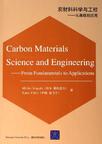炭材料科学与工程
2006-7
清华大学出版社
(日本)稻垣道夫、(中国)康飞宇/国别:中国大陆
610
910000
近年来由于富勒烯和碳纳米管的发现,炭材料研究受到了全球材料科学界、物理界和化学界的广泛关注。该书系统地介绍了炭材料的科学理论知识和工程应用实例。第一部分为绪论,介绍了写作本书的目的和炭材料的分类与发展史,以及炭的多样性。第二部分为炭材料的基础科学知识,主要介绍了炭材料的结构、性能和制备工艺,特别是炭化和石墨化的原理及其微观结构控制技术,多孔炭的孔径控制和炭材料掺杂其他原子的技术,炭材料的各类表征方法。第三部分主要为炭素材料的工程与应用问题,特别是新型炭材料的发展及其在能源、环保、原子能、国防方面的应用实例,涉及石墨电极,高密度各向同性石墨,高取向热解石墨,玻璃炭,纤维状炭,多孔炭,石墨层间化合物等。
作者:(日本)稻垣道夫 康飞宇
1 Introduction 1.1 Carbon Materials 1.2 Short History of Carbon Materials References 1.3 Classic Carbons, New Carbons and Nanocarbons 1.3.1 Classic carbons 1.3.2 New carbons 1.3.3 Nanocarbons References 1.4 Construction and Purposes of the Present Book2 Fundamentals of Carbon Materials 2.1 Carbon Families 2.1.1 Carbon?carbon bonds 2.1.2 Carbon families 2.1.3 Relations to neighboring atoms 2.2 Structure and Texture of Carbon Materials 2.2.1 Structure 2.2.2 Structural development with heat treatment(Carbonization and graphitization) 2.2.3 Nanotexture 2.2.4 Microtexture(Agglomeration) References 2.3 Nanotexture Development in Carbon Materials(Carbonization) 2.3.1 Formation processes of carbon materials 2.3.2 Gas phase carbonization 2.3.3 Solid phase carbonization 2.3.4 Liquid phase carbonization References 2.4 Novel Techniques for Carbonization 2.4.1 Template method 2.4.2 Polymer blend method 2.4.3 Pressure carbonization 2.4.4 High yield carbonization 2.4.5 Low temperature carbonization References 2.5 Structural Development in Carbon Materials(Graphitization) 2.5.1 Structure parameters 2.5.2 Graphitization behavior 2.5.3 Carbon materials with planar orientation 2.5.4 Carbon materials with axial orientation 2.5.5 Carbon materials with point orientation 2.5.6 Carbon materials with random orientation 2.5.7 Relations among structure parameters 2.5.8 Graphitization process 2.5.9 Graphitizing and non?graphitizing carbons 2.5.10 Heterogeneous graphitization(Multiphase graphitization) References 2.6 Acceleration of Graphitization 2.6.1 Catalytic graphitization 2.6.2 Stress graphitization 2.6.3 Graphitization of exfoliated carbon fibers References 2.7 Pore Development in Carbon Materials 2.7.1 Pores in carbon materials 2.7.2 Identification of pores in carbon materials……3 Engineering and Applications of Carbon MaterialsReferencesAcknowledgementsSubject Indexes
It has to be pointed out that the authors could not refer to all papers on carbonmaterials published in huge numbers of journals, and actually the authors did notintend to do so. The authors would like to give an overview on fundamentals ofscience and engineering of carbon materials from the point of view of structure andtexture. If the readers can get a general view on carbon materials and the fundamentalconcepts to understand and to study the carbon materials, it will be a great pleas-ure for the authors. In addition, the authors would like to ask all readers that referring to the original papers cited in this book, and also to many related papers,which were not cited in this book, is strongly suggested in order to understand inmore details. It has to be emphasized here once more that all published papers arenot cited in this book and that even many interesting and important papers aremissing here. One carbon material has different aspects. For an example, porous carbonswere produced through different processes, from carbonization of thermosettingprecursors associated with activation, through the template method without activation, from aerogels, from the carbonization of thermoplastic precursors, throughexfoliation of graphite via intercalation compounds, etc. The porous carbons thusprepared have a wide range of pores from rrucropores to macropores, and as a consequence are applied in various fields for adsorbents of various molecules, molecular sieving, storage of methane and hydrogen, sorption of viscous heavy oils,electrodes of electric double layer capacitors, etc. For another example, exfoliatedgraphite was used as the raw materials for flexible graphite sheets, which were applied in various fields of industries, but it is recently found to be a good sorbentfor heavy oils, a support for various catalyst metals, and also a raw material formetal carbides. Because of these reasons, porous carbons and exfoliated graphiteare explained in different chapters and sections in the present book. All carbonmaterials are in exactly the same situation. Therefore, the readers are strongly re-quested to read through whole parts of the present book first, even though they areinterested in a specialized carbon material, then to visit the sections which arewritten on the specified carbon material, and then the original papers cited and also those not cited in the present book. ……

五颗星,在炭材料的书籍中,这个算是比较有质量的了
这本书是碳材料方面很不错的书,推荐购买 特别是电池专业的
碳素材料,对我们做锂电的人很有用的资料
看同事买的,自己本想看看而已,不过最后还是决定买一本收藏。值得。不过可惜是06年版的,稍稍有点久远。
收到书了,很好的,免得东奔西跑了,非常感谢,赞一个
这本书很不错,但是封面有刮蹭的痕迹。
比正版差远了,但是在中国就凑合着用吧
英文感觉和美国有差异,内容挺好的
原汁原味,日本人写的,很详细,从最基础的讲起,脉络清晰,个人感觉蛮不错的,joyo的服务也很不赖!
炭材料领域的科普用书
专业书籍,值得一读。早该向康飞宇先生要一本的。
都不错,就是书有一点点脏
这是有关炭材料很有用的书,从基础到应用,一气呵成。读后很受启发。